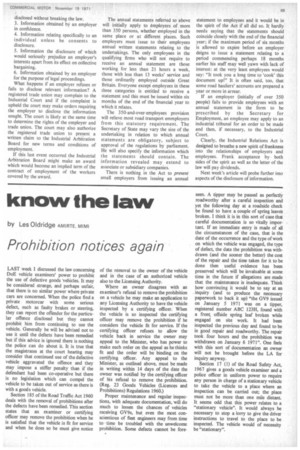Know the law
Page 67

If you've noticed an error in this article please click here to report it so we can fix it.
by Les Oldridge AMIRTE, MIMI
Prohibition notices again
LAST week I discussed the law concerning DoE vehicle examiners' power to prohibit the use of defective goods Vehicles. It may be considered strange, and perhaps unfair, that there is no similar power where private cars are concerned. When the police find a private motorcar with some serious defect, such as faulty brakes or steering, they can report the offender for the particular offence disclosed but they cannot prohibit him from continuing to use the vehicle. Generally he will be advised not to use it until the defects have been remedied but if this advice is ignored there is nothing the police can do about it. It is true that the magistrates at the court hearing may consider that continued use of the defective vehicle aggravated the offence and they may impose a stiffer penalty than if the defendant had been co-operative but there is no legislation which can compel the vehicle to be taken out of service as there is with a goods vehicle.
Section 185 of the Road Traffic Act 1960 deals with the removal of prohibitions after the defects have been remedied. This section states that an examiner or certifying officer may remove the prohibition when he is satisfied that the vehicle is fit for service and when he does so he must give notice of the removal to the owner of the vehicle and in the case of an authorized vehicle also to the Licensing Authority.
Where an owner disagrees with an examiner's refusal to remove the prohibition on a vehicle he may make an application to any Licensing Authority to have the vehicle inspected by a certifying officer. When the vehicle is so inspected the certifying officer may remove the prohibition if he considers the vehicle fit for service. If the certifying officer refuses to allow the vehicle back in service the owner may appeal to the Minister, who has power to make such order on the appeal as he thinks fit and the order will be binding on the certifying officer. Any appeal to the Minister, as outlined above, must be made in writing within 14 days of the date the owner was notified by the certifying officer of his refusal to remove the prohibition. (Reg. 23 Goods Vehicles (Licences and Prohibitions) Regulations 1960.)
Proper maintenance and regular inspections, with adequate documentation, will do much to lessen the chances of vehicles receiving GV9s, but even the most conscientious of fleet engineers may from time to • time be troubled with the unwelcome prohibition. Some defects cannot be fore
seen. A tipper may be passed as perfectly roadworthy after a careful inspection and yet the following day at a roadside check be found to have a couple of spring leaves broken. I think it is in this sort of case that careful documentation is so vitally important If an immediate entry is made of all the circumstances of the case, that is the date of the occurrence and the type of work on which the vehicle was engaged, the type of defect, the date the prohibition was withdrawn (and the sooner the better) the cost of the repair and the time taken for it to be done then useful evidence has been preserved which will be invaluable at some time in the future if allegations are made that the maintenance is inadequate. Think how convincing it would be to say at an inquiry (and to produce the necessary paperwork to back it up) "the GV9 issued on January 5 1971 was on a tipper, registered number ABC 123H, found with a front, offside spring leaf broken while engaged on site work. It had been inspected the previous day and found to be in good repair and roadworthy. The repair took. four hours and the prohibition was withdrawn on January 6 1971". One feels with this sort of documentation an owner will not be brought before the LA for inquiry anyway.
Section 17 (I) of the Road Safety Act, 1967 gives a goods vehicle examiner and a police officer in uniform power to require any person in charge of a stationary vehicle to take the vehicle to a place where an inspection can be carried out; the place must not be more than one mile distant. It seems odd that this power relates to a "stationary vehicle". It would always be necessary to stop a lorry to give the driver instructions to travel to the place to be inspected. The vehicle would of necessity be "stationary".




















































































































